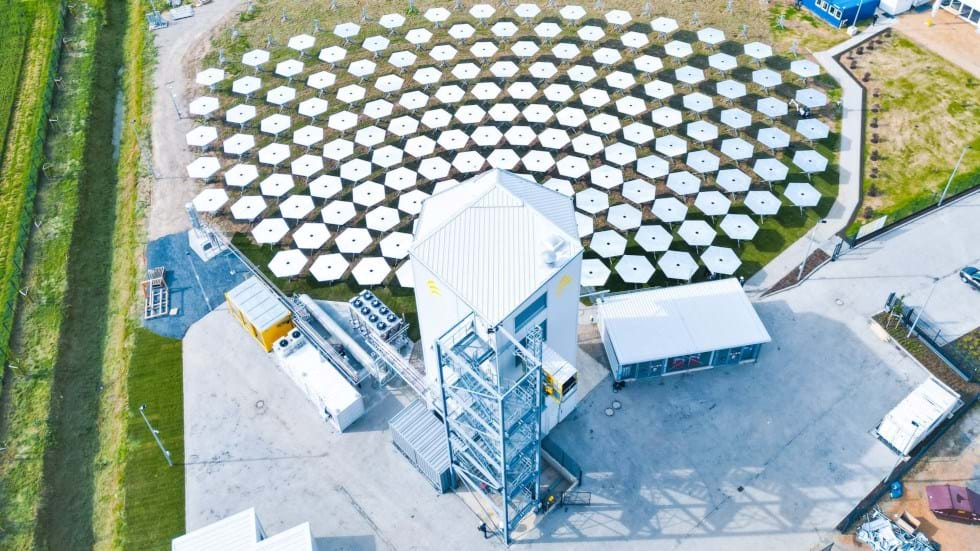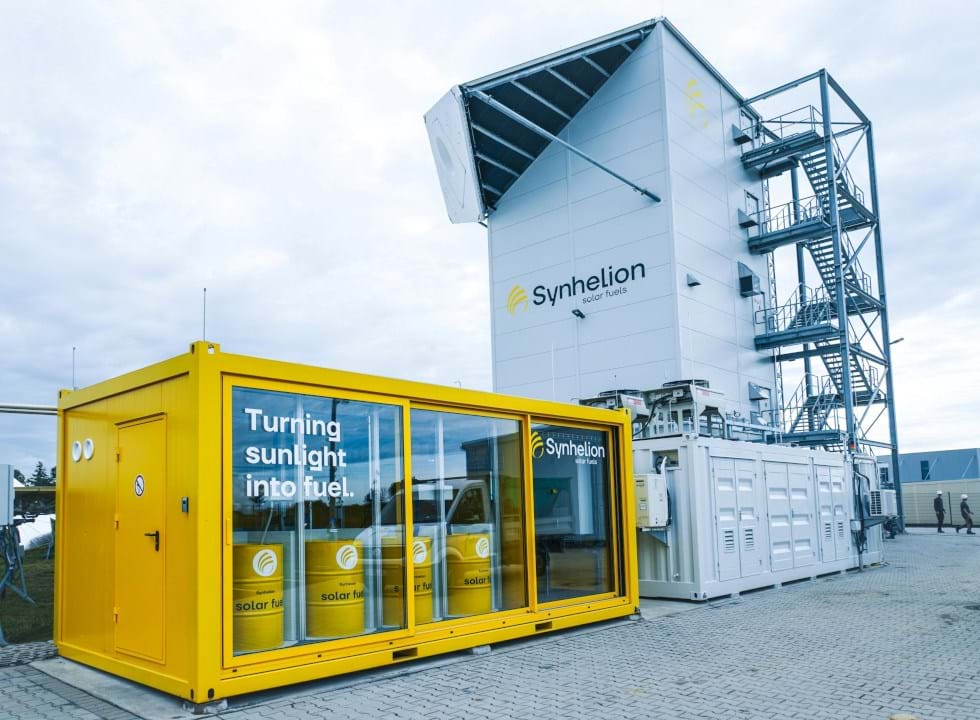Producing fuels from 1,500 degrees of solar heat: world’s first plant opens in Germany

THE WORLD’S first industrial plant using solar heat to make fuels has been opened in Germany. Using a vast array of mirrors that focus the sun’s heat onto a tower, the technology’s developer Synhelion plans to use its process to produce greener fuel for planes, ships and cars, and even low-carbon cement.
Known as DAWN, the plant is set to begin operations later this year, annually producing several thousand litres of fuel. Synhelion already has plans to build a much larger plant in Spain in 2025 that will ramp production up to around 1,000 t/y. And beyond that, its ambition is to be manufacturing 1m t/y within a decade. From 2033 it aims to produce fuels at around US$1/litre.
Philipp Furler, CEO and co-founder of Synhelion, commented: “Today is a historic day for Synhelion. The inauguration of DAWN marks the beginning of the era of solar fuels – a turning point for sustainable transportation. Our founding dream of producing renewable fuels from solar energy is becoming a reality.”
Heliostats and a reactor in a tower
Synhelion was founded in 2016 as a spin-off from ETH Zurich, sparked by what the company founders describe as a crazy idea they had: what if they could reverse combustion and turn carbon dioxide and water back into fuel?
The technology they’ve developed relies on four key components. Mirrors – known as heliostats – that track the sun to focus its energy on to a solar receiver. This in turn produces very high process heat at temperatures exceeding 1,500°C. This heat powers a thermochemical reactor that turns CO2, water and methane into syngas, which can be processed via Fischer-Tropsch into fuels. And finally, a thermal store to release energy when the sun goes down to allow the solar-powered facility to operate around the clock.
The plant has been built in Jülich close to its project partners, the German Aerospace Centre (DLR) and Aachen University’s solar institute. Combined, the mirrors have a total surface area of 1,500 m2 and provide a solar input power of 600 kW. The company says the design of its ultra-thin hexagonal mirrors are key to achieving such high process heats. It uses an AI-based method involving drones to calibrate the mirrors 200 times faster compared to traditional techniques using cameras, Synhelion says. Precision is key to ensure the mirrors track the sun and efficiently reflect its light into a solar receiver at the top of a 20 m tall tower.

The receiver heats a gaseous heat transfer fluid which circulates in a closed loop, delivering the high-temperate process heat to the thermochemical reactor and the thermal energy store. In the reactor, CO2, water vapour, and methane sourced from biowaste are heated with the solar energy over a catalyst which produces a mixture of carbon monoxide and hydrogen known as syngas. This is then piped down the tower to a Fischer-Tropsch unit which converts it into a synthetic crude which a refinery would then process into kerosene for planes, diesel or methanol for ships and trucks, and petrol for cars.
Speaking at the inauguration of the plant, Hartmut Höppner, state secretary at the German Federal Ministry for Digital and Transport, said: “The potential of renewable, synthetic fuels is huge. In order to achieve the climate targets in the transport sector, we need alternatives to fossil fuels. The first plant for the production of solar fuels in Germany is a clear sign of how technical innovations can help to reduce CO2 emissions.”
Partners in the project include potential customers for the fuel, Lufthansa and Swiss Airlines. Engineering firm Wood has helped Synhelion design, scale up and build its technology.
Synhelion is also working with Cemex to see whether the technology can be used to produce low carbon heat for cement production. In 2023, the partners announced they had produced clinker under plant-like and continuous conditions using solar heat. Clinker is typically produced in a rotary kiln heated to 1,500oC using fossil fuels. The pair said they will continue to work together to scale the technology.
Recent Editions
Catch up on the latest news, views and jobs from The Chemical Engineer. Below are the four latest issues. View a wider selection of the archive from within the Magazine section of this site.




